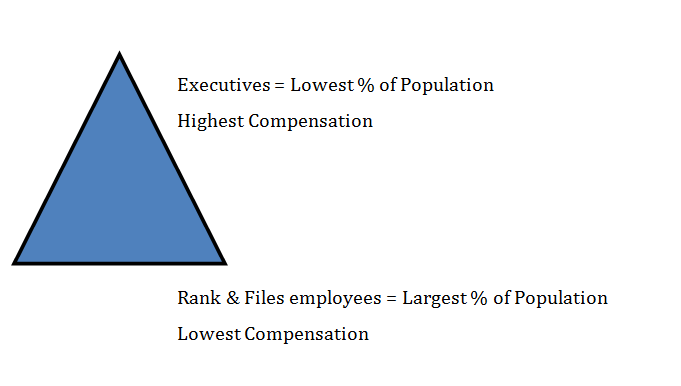Most large employers offer Group Long-Term Disability Insurance (LTD) to protect their employees’ income in the event of a disability. Historically, the objective has been to protect 60% of income (generally base salary only) to a maximum monthly benefit of $10,000 to $15,000. The cost is based on the type of business, the average age of the employees and the claims experience of the group.
Over the years, incomes have continued to rise so employers have been advised by insurance professionals to increase their group LTD benefit to protect the high income earners. Now, it’s not uncommon to find companies that offer benefits of $20,000 to $25,000 per month with many legal and accounting firms at $30,000 to $40,000 and some even higher. This is where the opportunity exists for companies to restructure their in-force programs to shift risk and save money. Think of how rates are determined and focus on average age and income. Now view the employees’ compensation as a pyramid.

As employers try to solve their disability insurance problem by increasing the level of group insurance, they are covering fewer employees with more protection which increases the exposure to the insurance company and in turn increases the group LTD rates for the employer. At the inception, this can seem like a very small expense because it’s communicated as 5 to 10 cents per $100 of covered payroll. Unfortunately, two things are frequently overlooked and need to be addressed.
1) The added cost is on all the Group coverage for the entire company, not just those employees that receive additional coverage when the benefit is increased from $20,000 to $25,000 per month. The additional 5 to 10 cents per hundred is multiplied across the companies’ total covered payroll, which can result in the cost being hundreds of thousands of dollars more than it may have initially appeared.
2) The employer also increases its exposure to shock claims, which occur when one of the higher compensated employees becomes disabled and the insurance company has to pay a significant group LTD benefit. This type of claim requires the insurance company to set aside a large amount of cash in reserve to pay it. Then on the plan’s anniversary, the insurance company can increase the group rate being charged to the whole company.
The large monthly benefit will also make it difficult to move the business to another company for rate relief.
This is where you can use individual disability insurance to shift the risk, improve the employers’ cost structure and even make more coverage available to those highly compensated employees that need it. The supplemental coverage can also be implemented on a voluntary basis.
Here is how it works:
First, approach the group LTD insurance company and ask them to run a few different coverage scenarios to better understand how the amount of monthly benefit effects your rates. For example, if the Group is currently $25,000 per month, have them provide rates at $20,000 and $15,000. Also, go up to $30,000 per month. This will provide you a clearer understanding of the rate sensitivity to the amount of coverage. It might very well be that you can get much better pricing if you move the group coverage back down to $20,000 or even $15,000 per month. Then you can shift the rest of the coverage to either a traditional supplemental disability product from a US insurance carrier or a new product offered through Lloyd’s of London.
Lloyd’s entered the white collar, guaranteed issue supplemental disability market about seven years ago. They now offer the largest amounts of coverage, best definitions of disability and the most competitive pricing. The cost savings available from reducing the group coverage will be significant. It will generally cover the cost of the supplemental plan and also provide additional savings to purchase more coverage for the highly compensated employees who are still exposed to a catastrophic financial loss should they become disabled. Lloyd's has brought a great deal of innovation and underwriting horsepower to the disability marketplace that US employers haven’t seen in years. This is a great time to re-evaluate your current program to see if there is a better, more cost-effective way to protect your employees.
Gary F. Terry is executive vice president and managing director of The Westport Group, Braintree, MA, and has more than 30 years of corporate planning expertise associated with executive benefits. He is one of the developers of the Executive Income Assurance Plan SM (Registered and approved with the United States Patent Office), a proprietary disability income plan designed in conjunction with Lloyd’s of London to protect highly compensated executives, both domestic and foreign. He can be reached at www.westportgp.com.
You may also enjoy: "Employee demands for disability insurance going unheard"
"The lucrative retirement market you're overlooking"
"Millennials ripe for disability insurance in ACA era"


